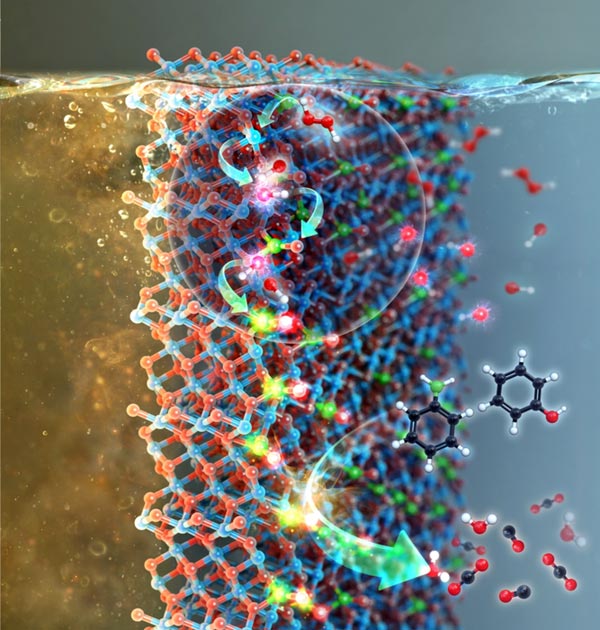Advance in water purification

Graphic image of the research
Credit: Korea Institute of Science and Technology (KIST)
Using radicalized NOX derivatives supported on metal oxides.
NOX is fused with oxygen on a metal oxide surface and forms supported NO3- acting as a decomposer (NO3 radical) of an aqueous pollutant upon radicalization.
NOX (X=1 or 2) emitted from stationery/mobile sources are conventionally deemed as notorious, anthropogenic precursors of ultrafine particulate matters (PM2.5) because NOX can undergo a series of SO2-assisted photochemical transformative stages to finally evolve PM2.5 functioning as an air pollutant. Recently, a research group in South Korea rectifies the general notion of NOX (vide supra) by proposing an interesting means to exploit NOX in creative fashion.
The Korea Institute of Science and Technology (KIST) has announced that a KIST research group with principal investigators of Dr. Jongsik Kim and Dr. Heon Phil Ha has collaborated with a research team led by Prof. Keunhong Jeong in the the Korea Military Academy (KMA) to graft NO3– species on a metal oxide via chemical fusion between NOX and O2 under a low thermal energy (≤ 150 °C). The resulting supported NO3– species can then be radicalized to generate NO3• analogues that serve as degraders of refractory organic substances present in a wastewater.
Aqueous recalcitrant compounds including phenolics and bisphenol A are typically eliminated from water matrices via sedimentation with the use of coagulants or via degradation into H2O and COY (Y=1 or 2) with the injection of OH shuttles such as H2O2, O3, etc. However, these methods require additional stages to recover coagulants or suffer from short lifespans and/or chemical instabilities innate to •OH, H2O2, and O3, thus severely limiting the sustainability of H2O purification processes currently being commercialized.
As a substitute of •OH, NO3• can be particularly appealing due to its longer lifetime and/or greater oxidizing potential in comparison with •OH, •OOH, or O2•-, thereby being predicted to enhance the efficiency in degrading aqueous pollutants over the other radicals stated above. Nevertheless, NO3• production is not trivial and has a bunch of constraints such as the need of highly energized electrons in the presence of a radioactive element or highly acidic environments.
Dr. Kim and co-workers make it viable under a wastewater including H2O2 and NO3–-functionalized manganese oxide that surface manganese species (Mn2+/Mn3+) initially activate H2O2 for the formation of •OH, whereas •OH subsequently activates NO3– functionality for its transition into NO3• (denoted as •OH → NO3•), all of which are evidenced by density functional calculation (DFT) techniques alongside with a bunch of control experiments.
The resulting NO3• species were demonstrated to escalate degradation efficiency of textile wastewater by five- or seven-fold compared to those provided by conventional radicals (•OH/•OOH/O2•-). Of significance, the catalyst (NO3–-functionalized manganese oxide) discovered herein is ~30 % cheaper than a traditional commercial catalyst (iron salt) and is mass-producible. Of additional significance, the catalyst is reusable ten times or more. This is in contrast to a traditional catalyst that only guarantees one-time utilization in decomposing aqueous pollutants via homogeneous H2O2 scission (•OH generation).
Dr. Kim remarks that “The •OH → NO3• technology has been patented and sold to a domestic company (SAMSUNG BLUETECH). Given a plenty of merits imparted by the catalyst modified with NO3– functionalities, we basically expect to install the catalyst in a wastewater treatment unit so soon.”
The Korea Institute of Science and Technology(KIST). Founded as the first multidisciplinary government-funded research institute in Korea, KIST established a national development strategy based on science and technology and disseminated various essential industrial technologies. Now, half a century later, KIST is elevating Korea’s status in the field of science and technology through world-leading fundamental technology R&D. Looking to the future, KIST will continue to strive to be a premier research institute, pursuing a brighter future for Korea and all of humanity.
This work is supported by the National Research Foundation of Korea (NRF) grant funded by government (Ministry of Science and ICT, Minister Hye-suk Lim) as well as the Future R & D and Young Fellow grants funded by KIST. This work is recently published in JACS Au, whose detail is JACS Au, 1 (2021) 1158.
Journal: JACS Au
DOI: 10.1021/jacsau.1c00124
Article Title: Deciphering Evolution Pathway of Supported NO3 radical Enabled via Radical Transfer from OH radical to Surface NO3- Functionality for Oxidative Degradation of Aqueous Contaminants
Article Publication Date: 23-Jun-2021
All latest news from the category: Life Sciences and Chemistry
Articles and reports from the Life Sciences and chemistry area deal with applied and basic research into modern biology, chemistry and human medicine.
Valuable information can be found on a range of life sciences fields including bacteriology, biochemistry, bionics, bioinformatics, biophysics, biotechnology, genetics, geobotany, human biology, marine biology, microbiology, molecular biology, cellular biology, zoology, bioinorganic chemistry, microchemistry and environmental chemistry.
Newest articles

New insights into the mechanisms of chromosome segregation errors
Research on centromere structure… Researchers from the Kops group in collaboration with researchers from the University of Edinburgh, made a surprising new discovery in the structure of the centromere, a structure…

“Topological hall effect” in two-dimensional quantum magnets
In a recent study published in Nature Physics, researchers from the Hefei Institutes of Physical Science of the Chinese Academy of Sciences, together with researchers of University of Science and Technology of China, have introduced the…

Coating Technologies of the Future
LZH and Cutting Edge Coatings at Optatec… At Optatec 2024, the Laser Zentrum Hannover e.V. (LZH) and Cutting Edge Coatings GmbH (CEC) present new opportunities in coating technologies for the…





















